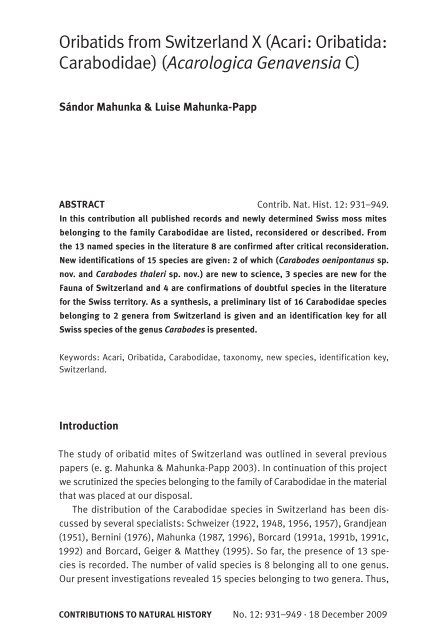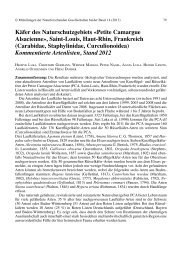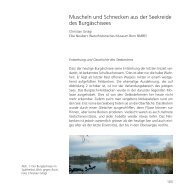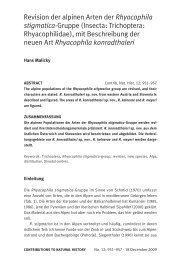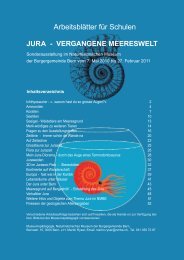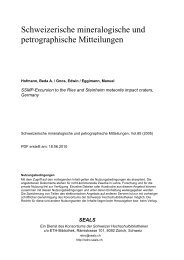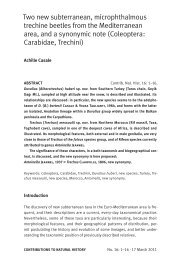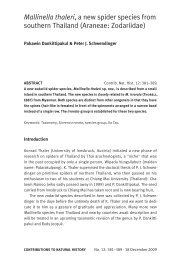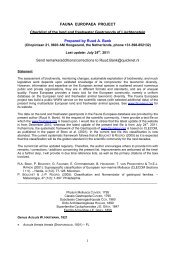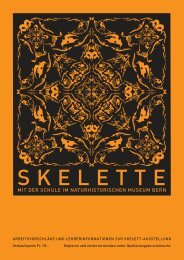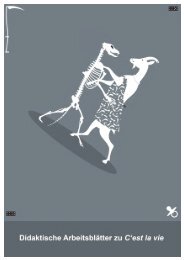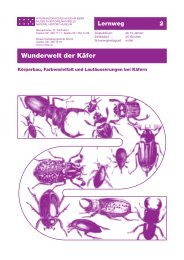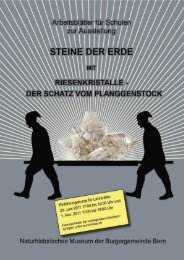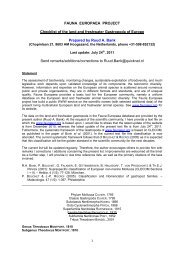Carabodes oenipontanus Mahunka & Mahunka-Papp
Carabodes oenipontanus Mahunka & Mahunka-Papp
Carabodes oenipontanus Mahunka & Mahunka-Papp
Create successful ePaper yourself
Turn your PDF publications into a flip-book with our unique Google optimized e-Paper software.
Oribatids from Switzerland X (Acari: Oribatida:<br />
Carabodidae) (Acarologica Genavensia C)<br />
sándor <strong>Mahunka</strong> & luise <strong>Mahunka</strong>-<strong>Papp</strong><br />
abstraCt Contrib. Nat. Hist. 12: 931–949.<br />
in this contribution all published records and newly determined swiss moss mites<br />
belonging to the family Carabodidae are listed, reconsidered or described. From<br />
the 13 named species in the literature 8 are confirmed after critical reconsideration.<br />
new identifications of 15 species are given: 2 of which (<strong>Carabodes</strong> <strong>oenipontanus</strong> sp.<br />
nov. and <strong>Carabodes</strong> thaleri sp. nov.) are new to science, 3 species are new for the<br />
Fauna of switzerland and 4 are confirmations of doubtful species in the literature<br />
for the swiss territory. as a synthesis, a preliminary list of 16 Carabodidae species<br />
belonging to 2 genera from switzerland is given and an identification key for all<br />
swiss species of the genus <strong>Carabodes</strong> is presented.<br />
Keywords: Acari, Oribatida, Carabodidae, taxonomy, new species, identification key,<br />
Switzerland.<br />
introduction<br />
The study of oribatid mites of Switzerland was outlined in several previous<br />
papers (e. g. <strong>Mahunka</strong> & <strong>Mahunka</strong>-<strong>Papp</strong> 2003). In continuation of this project<br />
we scrutinized the species belonging to the family of Carabodidae in the material<br />
that was placed at our disposal.<br />
The distribution of the Carabodidae species in Switzerland has been discussed<br />
by several specialists: Schweizer (1922, 1948, 1956, 1957), Grandjean<br />
(1951), Bernini (1976), <strong>Mahunka</strong> (1987, 1996), Borcard (1991a, 1991b, 1991c,<br />
1992) and Borcard, Geiger & Matthey (1995). So far, the presence of 13 species<br />
is recorded. The number of valid species is 8 belonging all to one genus.<br />
Our present investigations revealed 15 species belonging to two genera. Thus,<br />
Contributions to natural History No. 12: 931–949 · 18 December 2009
the present Swiss Fauna of Carabodidae comprises 16 species belonging to<br />
two genera. Here we describe two new species and we compiled an identification<br />
key for all Swiss species of the genus <strong>Carabodes</strong>.<br />
Concerning the terminology in describing the new species we heavily relied<br />
upon the works of Bernini (1976), <strong>Mahunka</strong> (1986), Reeves (1992) and Reeves<br />
& Behan-Pelletier (1998).<br />
Hitherto published species from switzerland<br />
The following list gives all recorded species in chronological order with the<br />
published names (in the original spelling without corrections) and (in bold<br />
type) the names currently considered as valid or, in the case of misidentifications,<br />
the correct species names.<br />
Schweizer (1922)<br />
pp. 62, 99:<br />
<strong>Carabodes</strong> coriaceus C. L. Koch = ?<br />
pp. 62, 99:<br />
<strong>Carabodes</strong> elongatus (Mich.) = ?<br />
pp. 62, 99:<br />
<strong>Carabodes</strong> marginatus (Mich.) = ?<br />
pp. 62, 99:<br />
Carbodes labyrinthicus (Mich.) = ?<br />
Schweizer (1948)<br />
pp. 12, 19:<br />
<strong>Carabodes</strong> femoralis (Nic.) = ?<br />
p. 19:<br />
<strong>Carabodes</strong> labyrinthicus (Mich.) = ?<br />
pp. 5, 9, 12, 19:<br />
<strong>Carabodes</strong> marginatus (Mich.) = ?<br />
pp. 11, 12, 19:<br />
<strong>Carabodes</strong> minusculus Berl. = <strong>Carabodes</strong> schatzi Bernini, 1976<br />
pp. 7, 8, 9, 11, 19:<br />
<strong>Carabodes</strong> areolatus Berl. = ?<br />
Grandjean (1951)<br />
pp. 262–263:<br />
<strong>Carabodes</strong> rugosior (Berl., 1916)<br />
932 Sándor <strong>Mahunka</strong> & Luise <strong>Mahunka</strong>-<strong>Papp</strong>
Schweizer (1956)<br />
pp. 293, 372:<br />
<strong>Carabodes</strong> areolatus Berlese, 1916<br />
pp. 294, 372:<br />
<strong>Carabodes</strong> forsslundi Sellnick, 1953 = <strong>Carabodes</strong> ornatus Storkán, 1925<br />
pp. 294–295, 372:<br />
<strong>Carabodes</strong> labyrinthicus (Michael, 1855)<br />
pp. 295, 372:<br />
<strong>Carabodes</strong> intermedius Willmann, 1951<br />
pp. 295–296, 372:<br />
<strong>Carabodes</strong> minusculus Berlese = <strong>Carabodes</strong> schatzi Bernini, 1976<br />
Schweizer (1957)<br />
pp. 46, 50, 58, 98, tab. IX:<br />
<strong>Carabodes</strong> areolatus<br />
pp. 46, 48, 49, 49, 50, 98, tab. IX:<br />
<strong>Carabodes</strong> labyrinthicus<br />
pp. 48, 98, tab. IX:<br />
<strong>Carabodes</strong> intermedius<br />
pp. 48, 48, 98, tab. IX:<br />
<strong>Carabodes</strong> minusculus = <strong>Carabodes</strong> schatzi Bernini, 1976<br />
pp. 51, 98, tab. IX:<br />
<strong>Carabodes</strong> forsslundi = <strong>Carabodes</strong> ornatus Storkán, 1925<br />
Bernini (1976)<br />
pp. 19–20:<br />
<strong>Carabodes</strong> schatzi Bernini, 1976: pro <strong>Carabodes</strong> minusculus in Schweizer<br />
(1956)<br />
<strong>Mahunka</strong> (1987)<br />
p. 402:<br />
<strong>Carabodes</strong> areolatus Berlese, 1916: in Schweizer (1956)<br />
p. 403:<br />
<strong>Carabodes</strong> intermedius Willmann, 1951: in Schweizer (1956)<br />
p. 404:<br />
<strong>Carabodes</strong> labyrynthicus (Michael, 1879): in Schweizer (1956)<br />
<strong>Carabodes</strong> ornatus Storkán, 1925: pro <strong>Carabodes</strong> forsslundi in Schweizer<br />
(1956)<br />
Oribatids from Switzerland<br />
933
p. 405:<br />
<strong>Carabodes</strong> schatzi Bernini, 1976: pro <strong>Carabodes</strong> minusculus in Schweizer<br />
(1956)<br />
Borcard (1991a)<br />
p. 308:<br />
<strong>Carabodes</strong> labyrinthicus (Michael) 1879<br />
Borcard (1991b)<br />
p. 332:<br />
<strong>Carabodes</strong> labyrinthicus (Michael) 1879<br />
Borcard (1991c)<br />
p. 526:<br />
<strong>Carabodes</strong> labyrinthicus (Michael) 1879<br />
<strong>Carabodes</strong> marginatus (Michael) 1884<br />
<strong>Carabodes</strong> rugosior (Berlese) 1916<br />
Borcard (1992)<br />
pp. 242–243:<br />
<strong>Carabodes</strong> areolatus Berlese, 1916<br />
pp. 242, 243:<br />
<strong>Carabodes</strong> forsslundi Sellnick, 1953 = <strong>Carabodes</strong> ornatus Storkán, 1925<br />
pp. 242, 243:<br />
<strong>Carabodes</strong> labyrinthicus (Michael) 1879<br />
pp. 242, 243–244:<br />
<strong>Carabodes</strong> marginatus (Michael) 1884<br />
pp. 242, 244:<br />
<strong>Carabodes</strong> rugosior (Berlese) 1916<br />
Borcard, Geiger & Matthey (1995)<br />
p. 325:<br />
<strong>Carabodes</strong> marginatus (Michael, 1884)<br />
<strong>Carabodes</strong> labyrinthicus (Michael,1879)<br />
<strong>Carabodes</strong> forsslundi Sellnick, 1953 = <strong>Carabodes</strong> ornatus Storkán, 1925<br />
<strong>Mahunka</strong> (1996)<br />
pp. 128–129:<br />
<strong>Carabodes</strong> wettsteini <strong>Mahunka</strong>, 1996<br />
934 Sándor <strong>Mahunka</strong> & Luise <strong>Mahunka</strong>-<strong>Papp</strong>
list of the published species accepted for the swiss Fauna<br />
<strong>Carabodes</strong> areolatus Berlese, 1916<br />
<strong>Carabodes</strong> intermedius Willmann, 1951<br />
<strong>Carabodes</strong> labyrinthicus (Michael, 1879)<br />
<strong>Carabodes</strong> marginatus (Michael, 1884))<br />
<strong>Carabodes</strong> ornatus Storkán, 1925<br />
<strong>Carabodes</strong> rugosior (Berlese, 1916)<br />
<strong>Carabodes</strong> schatzi Bernini, 1976<br />
<strong>Carabodes</strong> wettsteini <strong>Mahunka</strong>, 1996<br />
list of localities<br />
aP-1: SWITZERLAND: Appenzell: Hoher Kasten, sifting, 1600–1700 m; 18. VIII.<br />
1982; leg. C. Besuchet — (Bp-86).<br />
Fr-7: SWITZERLAND: Fribourg: Vaulruz, Derballys, decaying spruce stump, 900<br />
m; 2. IX. 1980; leg. S. Vit — (Bp-172).<br />
GE-6: SWITZERLAND: Geneva: Malval, mosses and lichens; 22. X. 1982; leg. C.<br />
Besuchet — (Bp-34).<br />
Gl-2: SWITZERLAND: Glarus: Hinterschwändi, peat-bog with Sphagnum sp.,<br />
1250 m; 6. X. 1994; leg. C. Besuchet — (Bp-87).<br />
Gr-1: SWITZERLAND: the Grisons: Gafia St. Antönien, mosses and grass roots;<br />
20. IX. 1983; leg. C. Besuchet — (Bp-51).<br />
Gr-5: SWITZERLAND: the Grisons: Swiss National Park, Il Fuorn, under a pile<br />
of dead branches, 1800 m; 22. IX. 1995; leg. C. Besuchet — (Bp-104).<br />
Gr-8: SWITZERLAND: the Grisons: Samnaun, alpine meadows with Rhododendron<br />
sp., sifting, 2050 m; 26. VIII. 1968; leg. C. Besuchet — (Bp-26).<br />
Gr-9: SWITZERLAND: the Grisons: Santa Maria – Umbrail Pass, sifting, 2000<br />
m; 5. VIII. 1974; leg. C. Besuchet — (Bp-37).<br />
Gr-11: SWITZERLAND: the Grisons: Untervaz near Chur, mosses; 29. IX. 1983;<br />
leg. C. Besuchet — (Bp-126).<br />
Gr-15: SWITZERLAND: the Grisons: Umbrail Pass, 2000 m; 25. VIII. 1968; leg.<br />
C. Besuchet — (Bp-149).<br />
Gr-16: SWITZERLAND: the Grisons: Val Bregaglia, Soglio, hollow chestnut<br />
stumps, 900 m; 10. IX. 1985; leg. C. Besuchet — (Bp-146).<br />
Gr-17: SWITZERLAND: the Grisons: Val Poschiavo, above Cavajone, at base of<br />
rocks and Rhododendron sp., 2050–2100 m; 27. VIII. 1983; leg. C. Besuchet<br />
— (Bp-151).<br />
Oribatids from Switzerland<br />
935
Gr-18: SWITZERLAND: the Grisons: Val Poschiavo, above Cavajone, under<br />
reeds and willows, 2250 m; 17.–18. VII. 1984; leg. C. Besuchet — (Bp-145).<br />
Ju-2: SWITZERLAND: Jura: Boncourt, old tree stumps; 11. III. 1978; leg. C.<br />
Besuchet — (Bp-173).<br />
lu-1: SWITZERLAND: Lucerne: Eigenthal, peat-bog Forenmoos near the village<br />
of Eigenthal, Sphagnum sp., 970 m; 2. VIII. 1996; leg. C. Besuchet — (Bp-<br />
108).<br />
lu-2: SWITZERLAND: Lucerne: above Gettnau (between Zell and Willisau), old<br />
ant-hill of Formica rufa L.; 1. VIII. 1996; leg. C. Besuchet — (Bp-107).<br />
lu-5: SWITZERLAND: Lucerne: Wohlhusen, old tree stumps; 17. III. 1979; leg.<br />
C. Besuchet — (Bp-176).<br />
so-1: SWITZERLAND: Solothurn: Ammansegg, mosses on floor of deciduous<br />
forest; 14. V. 1972; leg. S. <strong>Mahunka</strong> & L. <strong>Mahunka</strong>-<strong>Papp</strong> — (Bp-10).<br />
so-2: SWITZERLAND: Solothurn: Ammansegg, litter and dry leaves in mixed<br />
forest; 4. V. 1972; leg. S. <strong>Mahunka</strong> & L. <strong>Mahunka</strong>-<strong>Papp</strong> — (Bp-11).<br />
so-3: SWITZERLAND: Solothurn: Schnottwil, mosses; 27. IX. 1974; leg. S.<br />
<strong>Mahunka</strong> & L. <strong>Mahunka</strong>-<strong>Papp</strong> — (Bp-132).<br />
so-4: SWITZERLAND: Solothurn: Schnottwil, Bucheggberg, thick layer of mosses<br />
on floor of old pine forest; 27. IX. 1987; leg. S. <strong>Mahunka</strong> & L. <strong>Mahunka</strong>-<br />
<strong>Papp</strong> — (Bp-46).<br />
so-5: SWITZERLAND: Solothurn: Schnottwil, Bucheggberg, mosses on bark<br />
of a live deciduous tree; 27. IX. 1987; leg. S. <strong>Mahunka</strong> & L. <strong>Mahunka</strong>-<strong>Papp</strong><br />
— (Bp-47).<br />
so-6: SWITZERLAND: Solothurn: Schnottwil, Bucheggberg, dry needles in<br />
pine (Pinus sp.) forest; 27. IX. 1987; leg. S. <strong>Mahunka</strong> & L. <strong>Mahunka</strong>-<strong>Papp</strong><br />
— (Bp-48).<br />
tG-3: SWITZERLAND: Thurgau: Hudelmoos near Hagenwil, peat-bog with<br />
Sphagnum sp., 600 m; 13. IX. 1993; leg. C. Besuchet — (Bp-88).<br />
tG-7: SWITZERLAND: Thurgau: Müllheim, dry leaves in mixed forest; 13. IX.<br />
1987; leg. S. <strong>Mahunka</strong> & L. <strong>Mahunka</strong>-<strong>Papp</strong> — (Bp-42).<br />
tG-8: SWITZERLAND: Thurgau: Müllheim, rotten trunk with mosses; 13. IX.<br />
1987, leg. S. <strong>Mahunka</strong> & L. <strong>Mahunka</strong>-<strong>Papp</strong> — (Bp-43).<br />
tG-9: SWITZERLAND: Thurgau: between Bischofszell and Hauptwil, moss on<br />
forest floor with ferns; 11. VI. 1983; leg. T. & Z. Adamis — (Bp-21).<br />
tG-10: SWITZERLAND: Thurgau: between Bischofszell and Hauptwil, moss on<br />
forest floor and dry needles in pine (Pinus sp.) forest; 11. VI. 1983; leg. T.<br />
& Z. Adamis — (Bp-22).<br />
ti-3: SWITZERLAND: Ticino: Bordei at base of Mount Gridone ("massif de<br />
refuge"), old chestnut stumps in forest, sifting, 700 m; 24. IV. 1992; leg. C.<br />
Besuchet — (Bp-90).<br />
936 Sándor <strong>Mahunka</strong> & Luise <strong>Mahunka</strong>-<strong>Papp</strong>
ti-9: SWITZERLAND: Ticino: Nufenen Pass, dry leaves and rotten wood in larch<br />
forest; 15. VI. 1979; leg. S. <strong>Mahunka</strong> & L. <strong>Mahunka</strong>-Pap — (Bp-18).<br />
ti-11: SWITZERLAND: Ticino: Rancate, chestnut forest, sifting; 7. IX. 1965; leg.<br />
C. Besuchet — (Bp-25).<br />
ti-16: SWITZERLAND: Ticino: Serpiano, dead leaves in oak forest; 14. VI. 1979;<br />
leg. S. <strong>Mahunka</strong> & L. <strong>Mahunka</strong>-<strong>Papp</strong> — (Bp-16).<br />
ti-17: SWITZERLAND: Ticino: Serpiano, mosses on floor of oak forest; 14. VI.<br />
1979; leg. S. <strong>Mahunka</strong> & L. <strong>Mahunka</strong>-<strong>Papp</strong> — (Bp-17).<br />
ti-22: SWITZERLAND: Ticino: Cortascio above Brissago, sifting in ravine, 1050<br />
m; 22. IV. 1992; leg. C. Besuchet — (Bp-157).<br />
ti-23: SWITZERLAND: Ticino: Alpe d' Arena above Vergeletto, at base of rocks,<br />
1700 m; 22. VII. 1983; leg. C. Besuchet — (Bp-142).<br />
ti-25: SWITZERLAND: Ticino: Centovalli, Moneto, dead leaves, 800 m; 23. VII.<br />
1983; leg. C. Besuchet — (Bp-144).<br />
ti-26: SWITZERLAND: Ticino: Valle Onsernone, Spruga, mosses and humus,<br />
1000 m; 22. VII. 1983; leg. C. Besuchet — (Bp-141).<br />
ti-37: SWITZERLAND: Ticino: Rancate, old tree stump, extraction by flotation<br />
of soil; 5. VI. 1969; leg. C. Besuchet & I. Löbl (Te-69/34) — (Bp-192).<br />
ti-38: SWITZERLAND: Ticino: Ascona, Monte Verità, dead leaves and soil, 450<br />
m; 5. XI. 1984; leg. C. Besuchet — (Bp-210).<br />
ti-40: SWITZERLAND: Ticino: Brissago, dead leaves and old tree stump; 26.<br />
IV. 1985; leg. C. Besuchet & I. Löbl — (Bp-215).<br />
ti-42: SWITZERLAND: Ticino: Cortascio above Brissago, sifting of mosses,<br />
900 m; 20. V. 1998; leg. C. Besuchet — (Bp-229).<br />
ur-1: SWITZERLAND: Uri: Klausen Pass, litter of Rhododendron sp., 2000 m;<br />
23. VIII. 1983; leg. I. Löbl — (Bp-60).<br />
VD-4: SWITZERLAND: Vaud: La Dôle, litter and dead leaves in alder forest,<br />
1000 m; 7. V. 1972; leg. S. <strong>Mahunka</strong> & L. <strong>Mahunka</strong>-<strong>Papp</strong> — (Bp-8).<br />
Vs-4: SWITZERLAND: Valais: Daubensee, mosses and grass, 2200 m; 11. VIII.<br />
1980; leg. C. Besuchet — (Bp-32).<br />
Vs-11: SWITZERLAND: Valais: Grammont, sifting of mosses, 2000 m; 30. VI.<br />
1989; leg. C. Besuchet — (Bp-79).<br />
Vs-41: SWITZERLAND: Valais: Val d'Anniviers, mosses, 1100 m; 11. V. 1980;<br />
leg. S. Vit — (Bp-222).<br />
Vs-44: SWITZERLAND: Valais: Saas-Almagell, waterlogged mosses, 1650 m;<br />
5. VII. 1997; leg. C. Besuchet — (Bp-225).<br />
Vs-45: SWITZERLAND: Valais: St. Maurice, dead leaves at base of rocks; 11.<br />
VII. 1980; leg. C. Besuchet — (Bp-226).<br />
Vs-46: SWITZERLAND: Valais: Val d'Anniviers, St. Jean, decaying wood, 1300<br />
m; 11. V. 1980; leg. S. Vit — (Bp-227).<br />
Oribatids from Switzerland<br />
937
Vs-47: SWITZERLAND: Valais: Val d'Anniviers, St. Jean, ash-tree and Lasius sp.,<br />
1400 m; 11 .V. 1980; leg. S. Vit — (Bp- 228).<br />
Vs-48: SWITZERLAND: Valais: Vouvry, layer of mosses from a rocky slope<br />
on the trail to the cave "Grotte de la Pierre à Perret", (B), 460 m; 10. VIII.<br />
1989; leg. B. Hauser — (Bp-237).<br />
Vs-52: SWITZERLAND: Valais: above Haute-Nendaz, mosses, 1800 m; 2. VII.<br />
1981; leg. C. Besuchet — (Bp-241).<br />
Vs-53: SWITZERLAND: Valais: Traquit; VIII. 1944; leg. E. Wettstein — (Bp-242).<br />
Vs-54: SWITZERLAND: Valais: Cr. de la Lex; 22. VIII. 1944; leg. E. Wettstein —<br />
(Bp-243).<br />
list of newly determined swiss species<br />
<strong>Carabodes</strong> C. L. Koch, 1835<br />
<strong>Carabodes</strong> areolatus Berlese, 1916<br />
<strong>Carabodes</strong> areolatus Berlese 1916: 331.<br />
Localities: GR-5, SO-5, TI-22, TI-23, TI-37, TI-38, TI-40, VS-47.<br />
Distribution: Holarctic Region.<br />
<strong>Carabodes</strong> coriaceus C. L. Koch, 1835<br />
<strong>Carabodes</strong> coriaceus C. L. Koch 1835: 3, 15.<br />
Localities: GE-6, GR-8, LU-2, SO-2, SO-6, TG-3, TI-17, TI-25, TI-42.<br />
Distribution: Holarctic Region; confirmation of the swiss record.<br />
<strong>Carabodes</strong> femoralis (Nicolet, 1855)<br />
Tegeocranus femoralis Nicolet 1855: 466, pl. 9: 1, 1a–f, 2.<br />
Localities: LU-5, SO-1, TG-3, TG-8, TI-17, TI-22, TI-40, VS-4.<br />
Distribution: Europe; confirmation of the swiss record.<br />
<strong>Carabodes</strong> intermedius Willmann, 1951<br />
<strong>Carabodes</strong> intermedius Willmann 1951: 169, fig. 11.<br />
Localities: VS-53, VS-54.<br />
Distribution: Europe (Alps).<br />
Remarks: The identified specimens are mounted on 2 slides: W. 1149 (VS-53)<br />
and W. 1150 (VS-54) and are part of the Wettstein collection, which is deposited<br />
in the Naturhistorisches Museum, Basel (see: <strong>Mahunka</strong> 1996, Pestalozzi<br />
1962). Apart from the scant locality labels on the slides, no other documen-<br />
938 Sándor <strong>Mahunka</strong> & Luise <strong>Mahunka</strong>-<strong>Papp</strong>
tation on the provenance of this material exists. Thanks to the helpful information<br />
by Dr. Y. Gonseth (Neuchâtel) 1 we are sure that the specimens were<br />
collected in the canton of Valais. Concerning "Traquit": there exists a mountain<br />
hut called "Cabane Tracuit" (618/108), 3256 m, (= cabane de Traquit),<br />
a pass called "Col Tracuit" (618/108), 3250 m and also an alpine pasture<br />
"Alpage Tracuit" (616/108) 2600 m above Zinal. Concerning "Cr. de la Lex":<br />
there exists a "Croix de la Lé" (553/134) above Port Valais and a "Creux de la<br />
Lé" near the pass "Col du Sanetsch" (587/133) 2300 m.<br />
<strong>Carabodes</strong> labyrinthicus (Michael, 1879)<br />
Tegeocranus labyrinthicus Michael 1879: 249, pl. 11: 2–3.<br />
Localities: AP-1, FR-7, GR-1, GR-5, GR-15, GR-17, GR-18, JU-2, LU-2, SO-1, SO-4,<br />
SO-6, TG-8, TG-9, TI-38, UR-1, VD-4, VS-4, VS-52.<br />
Distribution: Holarctic Region.<br />
<strong>Carabodes</strong> marginatus (Michael, 1884)<br />
Tegeocranus marginatus Michael 1884: 322, pl. 21: 5, pl. 22: 1–2.<br />
Localities: GR-5, GR-9, GR-11, GR-15, GR-17, LU-2, SO-3, TG-3, TI-9, TI-17,<br />
VS-44.<br />
Distribution: Palaearctic Region.<br />
<strong>Carabodes</strong> minusculus Berlese, 1923<br />
<strong>Carabodes</strong> minusculus Berlese 1923: 257.<br />
Localities: GR-15, GR-18, TI-3, TI-23, VS-11.<br />
Distribution: Europe; confirmation of the swiss record.<br />
<strong>Carabodes</strong> <strong>oenipontanus</strong> sp. nov.<br />
Locality: TI-37.<br />
Description: see below.<br />
<strong>Carabodes</strong> ornatus Storkán, 1925<br />
<strong>Carabodes</strong> ornatus Storkán 1925: 21, fig. 4.<br />
Localities: GR-5, GR-11, TG-7, TI-3, TI-25, TI-40, VS-41, VS-48.<br />
Distribution: Palaearctic Region.<br />
<strong>Carabodes</strong> reticulatus Berlese, 1913<br />
<strong>Carabodes</strong> coriaceus Koch var. reticulatus Berlese 1913: 95, pl. 7: 74.<br />
1 translation in English of the e-mail of 22. IX. 2006 to Dr. B. Hauser<br />
Oribatids from Switzerland<br />
939
Localities: TI-22, UR-1, VS-41, VS-47.<br />
Distribution: Europe; first record for switzerland.<br />
<strong>Carabodes</strong> rugosior Berlese, 1916<br />
<strong>Carabodes</strong> femoralis Nicolet var. rugosior Berlese 1916: 327.<br />
Localities: FR-7, LU-1, SO-4, TG-3, TG-9, TI-23, TI-26, TI-42, VS-41.<br />
Distribution: Holarctic Region.<br />
<strong>Carabodes</strong> schatzi Bernini, 1976<br />
<strong>Carabodes</strong> schatzi Bernini 1976: 16–20, figs. V: a–b.<br />
Localitiy: GR-9, TI-38, TI-42.<br />
Distribution: Europe (Alps); first record for switzerland.<br />
<strong>Carabodes</strong> tenuis Forsslund, 1953<br />
<strong>Carabodes</strong> tenuis Forsslund 1953: 373–375, figs. 2–3.<br />
Localities: GL-2, TI-9.<br />
Distribution: N-Europe, Alps; first record for switzerland.<br />
<strong>Carabodes</strong> thaleri sp. nov.<br />
Locality: VS-46.<br />
Description: see below.<br />
Odontocepheus Berlese, 1913<br />
Odontocepheus elongatus (Michael, 1879)<br />
Tegeocranus elongatus Michael 1879: 250, pl. 10: 7–10.<br />
Localities: GR-16, LU-5, TG-10, TI-11, TI-16, TI-22, TI-37, TI-40, TI-42, VS-45.<br />
Distribution: Palaearctic Region; confirmation of the swiss record.<br />
940 Sándor <strong>Mahunka</strong> & Luise <strong>Mahunka</strong>-<strong>Papp</strong>
Description of new species<br />
<strong>Carabodes</strong> <strong>oenipontanus</strong> sp. nov. (Figs. 1–5)<br />
Material examined: Switzerland: Holotype: Ticino: TI-37 (MHNG 2 ).<br />
Paratypes: 4 Ex. from the same sample. 2 paratypes: MHNG 2 and 2 paratypes<br />
(1661-P0-02): HNHM 3 .<br />
Diagnosis: Prodorsum foveolate anteriorly and rugose in basal part medially,<br />
with a stronger, crest-like structure transversally in front of the notogaster.<br />
Interlamellar and notogastral setae dilated, with median crest and spicules.<br />
Sensillus long (Fig. 4), its head spiculate and multiramose, with short branches.<br />
Circumgastric depression present, notogastral surface alveolate. Epimeral setal<br />
formula: 3-1-3-3. Anogenital setal formula: 4-1-2-3.<br />
Measurements: Length of body: 396–445 µm, width of body: 198–220 µm.<br />
Prodorsum: Rostrum, rostral part of prodorsum and whole surface of<br />
lamellae distinctly foveolate. Median surface of prodorsum, posterior to interlamellar<br />
setae, irregularly rugose, rugae running longitudinally (Fig. 5). The<br />
intermediate fields formed by confluent foveolae. This region bordering a<br />
strong discontinuous crest basally. Rostrum slightly elongate. Rostral setae<br />
long, curved inwards, slightly bacilliform with pointed apex (Fig. 1). Lamellae<br />
normal, well sculptured by foveolae, bearing the short, wide, lamellar setae.<br />
Interlamellar setae wide, arising on the prodorsal surface, nearly penicilliform.<br />
Sensillus long (Fig. 4), its head spiculate and multiramose, with short branches.<br />
Dorsosejugal depression hardly observable, only a narrow slit visible.<br />
Notogaster: Anterior margin slightly undulate. Humeral process small, wide.<br />
Circumgastric depression present. Whole surface irregularly foveolate, border<br />
of the foveolae consisting of small arches, appearing flower-shaped (Fig. 3).<br />
Ten pairs of broad, clavate, distinctly barbed notogastral setae, with high<br />
median crest.<br />
Ventral regions (Fig. 2): Mentum, epimeral surface with simple, normal<br />
foveolae, ventral plate with larger and irregular ones, genital and anal plates<br />
also foveolate, but with deeper and smaller foveolae. Coxisternal, genital and<br />
aggenital setae simple, spiniform. Anal setae and setae ad 3 setiform, setae<br />
ad 1 and ad 2 ciliate, spiculate.<br />
2 MHNG = deposited in the Muséum d‘Histoire naturelle, Geneva.<br />
3 HNHM = deposited in the Hungarian Natural History Museum, Budapest, with identification number<br />
of the specimens in the Collection of Arachnida.<br />
Oribatids from Switzerland<br />
941
1 2<br />
Figs. 1–5. <strong>Carabodes</strong> <strong>oenipontanus</strong> sp. nov. – 1: body in dorsal view; – 2: body in ventral view; – 3:<br />
notogastral surface with setae; – 4: trichobothrium; – 5: surface of the basal part of the prodorsum<br />
with interlamellar setae.<br />
942 Sándor <strong>Mahunka</strong> & Luise <strong>Mahunka</strong>-<strong>Papp</strong><br />
5<br />
4<br />
3
Legs: Femur of legs I and II, trochanter and femur of legs III–IV foveolate.<br />
Setae u in all legs long, attenuate.<br />
Remarks: The new species belongs to the "minusculus" group with a sensillus<br />
grooved at tip. It is more similar to <strong>Carabodes</strong> granulatus Banks, 1895,<br />
however it differs from that species by the median sculpture of prodorsum (no<br />
longitudinal ridges in C. granulatus), much larger notogastral setae and by the<br />
shape of notogastral setae (penicilliform in C. granulatus).<br />
Derivatio nominis: We dedicate this species to the late Konrad Thaler (1940–<br />
2005) as an outstanding representant of the Innsbruck School of Alpine Zoology<br />
(Oenipons = Latin translation of Innsbruck).<br />
Established in 1863 by Camillo Heller (1823–1917), the first holder of the<br />
professorial chair of modern Zoology at the Innsbruck University, the Tyrolian<br />
center of high altitude zoology (in German "Hochgebirgszoologie"), counts<br />
furthermore such famous naturalists as Karl Wilhelm von Dalla Torre (1850–<br />
1928), Otto Steinböck (1893–1969) and Heinz Janetschek (1913–1997) in its<br />
lineage (more details in: Janetschek, 1969, Thaler, 1997).<br />
<strong>Carabodes</strong> thaleri sp. nov. (Figs. 6–11)<br />
Material examined: Switzerland: Holotype: Valais: VS–4 (MHNG).<br />
2 paratypes from the same sample. 1 paratype: MHNG and 1 paratype<br />
(1691-P0-05): HNHM.<br />
Diagnosis: Prodorsum foveolate anteriorly and tuberculate in basal part<br />
medially, with a stronger, crest-like structure transversally in front of the notogaster.<br />
Interlamellar and notogastral setae dilated, with median crest and<br />
spicules. Sensillus long, straight, its narrow head divided. Notogastral surface<br />
tuberculate. Epimeral setal formula: 3-1-3-3. Anogenital setal formula: 4-1-<br />
2-3.<br />
Measurements: Length of body: 433–472 µm, width of body: 220–248 µm.<br />
Prodorsum: Rostral apex, a small part of prodorsum and surface of lamellae<br />
distinctly foveolate. Median and basal surface of prodorsum distinctly<br />
tuberculate. This region bordering a strong crest basally (Fig. 6). Rostral and<br />
lamellar setae long, roughened, curved inwards, slightly bacilliform with<br />
pointed apex. Lamellae normal, well sculptured by foveolae, bearing the<br />
lamellar and interlamellar setae (Fig. 8). The latter setae wide, nearly plumose.<br />
Sensillus long, straight, its narrow head divided (Fig. 7). Dorsosejugal<br />
depression narrow, distinct, as a narrow slit. Tutorum (Fig. 11) well developed.<br />
Notogaster: Anterior margin straight. Humeral process small, but well<br />
observable. Whole surface except the humeral parts irregularly tuberculate,<br />
Oribatids from Switzerland<br />
943
6<br />
Figs. 6–11. <strong>Carabodes</strong> thaleri sp. nov. – 6: body in dorsal view; – 7: sensillus; – 8: interlamellar seta;<br />
– 9: body in ventral view; – 10: notogastral surface with seta la; – 11: body in lateral view.<br />
944 Sándor <strong>Mahunka</strong> & Luise <strong>Mahunka</strong>-<strong>Papp</strong><br />
7<br />
8<br />
11<br />
9<br />
10
order of the tubercles indistinct. Above the tubercles a granulate layer present<br />
(Fig. 10). Ten pairs of broad, clavate, distinctly barbed notogastral setae, with<br />
median crest.<br />
Ventral regions (Fig. 9): Infracapitulum rarely foveolate, epimeral surface<br />
nearly smooth, but the granulate layer also present. Ventral plate with larger<br />
and irregular tubercles, genital plates with longitudinal ribs, anal plates also<br />
foveolate. Coxisternal, genital and aggenital setae simple, spiniform. Anal<br />
setae and setae ad 3 setiform, setae ad 1 and ad 2 ciliate, spiculate.<br />
Legs: Femur of legs I and II, trochanter and femur of legs III–IV foveolate.<br />
Setae u in all legs long, attenuate.<br />
Remarks: The new species is well characterised by the dorsal and ventral<br />
sculpture, the shape of the interlamellar and notogastral setae and the shape<br />
of the sensilli. This combination of the features was unknown in the genus<br />
<strong>Carabodes</strong> until now.<br />
Derivatio nominis: This species is dedicated to the memory of our friend<br />
and renowned arachnologist, the late Prof. Dr. Konrad Thaler (Innsbruck), who<br />
was the first who invited us in 1969 to collect mites in Central Europe (Obergurgl)<br />
on the other side of the iron curtain.<br />
a preliminary list of swiss Carabodidae<br />
<strong>Carabodes</strong> areolatus Berlese, 1916<br />
<strong>Carabodes</strong> coriaceus C. L. Koch, 1835<br />
<strong>Carabodes</strong> femoralis (Nicolet, 1855)<br />
<strong>Carabodes</strong> intermedius Willmann, 1951<br />
<strong>Carabodes</strong> labyrinthicus (Michael, 1879)<br />
<strong>Carabodes</strong> marginatus (Michael, 1884)<br />
<strong>Carabodes</strong> minusculus Berlese, 1923<br />
<strong>Carabodes</strong> <strong>oenipontanus</strong> sp. nov.<br />
<strong>Carabodes</strong> ornatus Storkán, 1925<br />
<strong>Carabodes</strong> reticulatus Berlese, 1913<br />
<strong>Carabodes</strong> rugosior Berlese, 1916<br />
<strong>Carabodes</strong> schatzi Bernini, 1976<br />
<strong>Carabodes</strong> tenuis Forsslund, 1953<br />
<strong>Carabodes</strong> thaleri sp. nov.<br />
<strong>Carabodes</strong> wettsteini <strong>Mahunka</strong>, 1996<br />
Odontocepheus elongatus (Michael, 1879)<br />
Oribatids from Switzerland<br />
945
Key to <strong>Carabodes</strong> of switzerland<br />
1 (24) Setae c 2 originating medially, far from the shoulder, in the longitudinal<br />
line of setae lm and lp<br />
2 (17) Entire inner surface of notogaster comprising convex elements: tubercles,<br />
pustules, granules or rugae, without areolae<br />
3 (4) Entire inner surface of notogaster with rugulose sculpture, at places<br />
interrupted by narrow furrows. Setae c 2 of notogaster much longer than<br />
the other notogastral setae and clearly directed forwards<br />
.......................................................................... intermedius Willmann<br />
4 (3) Inner surface of notogaster with more or less independent roundish or<br />
polygonate outgrowths. Setae c 2 of notogaster differing neither in length<br />
nor in direction from the other notogastral setae<br />
5 (8) Dorsosejugal depression very narrow, slit-like, sometimes hardly discernible<br />
6 (7) Notogastral setae erect. Setae c 2 not longer than the other notogastral<br />
setae.............................................................................. schatzi Bernini<br />
7 (6) Setae of notogaster adpressed on body surface. Setae c 2 much longer<br />
than the other notogastral setae...................................minusculus Berlese<br />
8 (5) Dorsosejugal depression wide, well discernible<br />
9 (14) Inner and marginal setae of notogaster approximately of the same<br />
length, or the marginal setae somewhat longer than the inner ones<br />
10 (11) Inner surface of notogaster with clearly delimited tubercula forming<br />
clear polygonal sculpture...........................................marginatus (Michael)<br />
11 (10) Sculpture of notogaster different, without clearly delimited tubercula<br />
forming a polygonal structure, sculpture comprising merely tubercula<br />
12 (13) Interlamellar and notogastral setae narrow, simple. Sensillus curved<br />
.............................................................................. wettsteini <strong>Mahunka</strong><br />
13 (12) Interlamellar and notogastral setae plumose. Sensillus straight<br />
........................................................................................ thaleri sp. nov.<br />
14 (9) Marginal setae only about half as long as length of inner ones<br />
15 (16) Notogaster covered with tubercula arranged on twisting, broad rugae<br />
...............................................................................coriaceus C. L. Koch<br />
16 (15) Notogastral tubercula small, forming an irregular, blurred polygonal<br />
sculpture ............................................................................ornatus Storkán<br />
17 (2) Entire inner surface of notogaster comprising areolae and hollows, at<br />
most they are framed by keels and polygonal tubercula<br />
18 (19) All notogastral and interlamellar setae strongly broadened: phylliform<br />
.............................................................................<strong>oenipontanus</strong> sp. nov.<br />
19 (18) All notogastral and interlamellar setae setiform, stick- or spindle-<br />
946 Sándor <strong>Mahunka</strong> & Luise <strong>Mahunka</strong>-<strong>Papp</strong>
shaped, at most only some may be slightly broadened<br />
20 (21) Size of notogastral alveoli identical, separated from each other, no<br />
polygonal sculpture visible around them ......................... tenuis Forsslund<br />
21 (20) Size of notogastral alveoli different, framed by polygonal sculpture<br />
22 (23) Dorsosejugal depression wide, anterior margin arcuating anteriad.<br />
Anterior margin of notogaster with a large, median tuberculum. Interlamellar<br />
setae broadening anteriorly, straight........................reticulatus Berlese<br />
23 (22) Dorsosejugal depression narrow, anterior margin straight. Anterior<br />
margin of notogaster without a tuberculum.....................areolatus Berlese<br />
24 (1) Setae c 2 originating laterally, near the shoulder, in the longitudinal line<br />
of setae la and h 2<br />
25 (26) Notogastral and interlamellar setae longer than sensillus. Notogastral<br />
sculpture comprising regularly dispersed tubercula confluent into rugae<br />
......................................................................... labyrinthicus (Michael)<br />
26 (25) Notogastral and interlamellar setae much shorter than sensillus. Notogaster<br />
with larger rugae and a medial outgrowth<br />
27 (28) Surface of notogastral rugae with granules. Notogastral setae stickshaped<br />
...............................................................................rugosior Berlese<br />
28 (27) Notogastral rugae with tubercula. Notogastral setae broadened<br />
................................................................................femoralis (Nicolet)<br />
acknowledgements<br />
We wish to thank the collectors of the material, mainly Dr. C. Besuchet. For<br />
the opportunity to study the material in the Geneva Museum we have to thank<br />
the curator, Dr. P. Schwendinger, and the Director, Dr. V. Mahnert. Special<br />
thanks are also due to Dr. B. Hauser for his efforts in editing our paper including<br />
the support with historical data about Innsbruck and for all the technical<br />
assistance with the Geneva collection. We thank the Director of the Centre<br />
suisse de cartographie de la faune (CSCF), Dr Y. Gonseth, in Neuchâtel for<br />
the valuable information on Swiss localities transmitted to Dr. Hauser. For<br />
the linguistic revision of the manuscript we extend our sincere thanks to Dr. L.<br />
Zombori. For the careful reading of the manuscript and his useful comments<br />
and suggestions our best thanks go to Dr. Heinrich Schatz (Institute of Zoology,<br />
Innsbruck). This project was partly supported by the Hungarian Scientific<br />
Research Fund (OTKA T-45889).<br />
Oribatids from Switzerland<br />
947
eferences<br />
Bernini, F. (1976): Notulae Oribatologicae XIV. Revisione di <strong>Carabodes</strong> minusculus Berlese<br />
1923 (Acarida, Oribatei). — Redia 54: 1–49.<br />
Borcard, D. (1991a): Les Oribates des tourbières du Jura suisse (Acari, Oribatei): Écologie. I.<br />
Quelques aspects de la communauté d'Oribates des sphaignes de la tourbière du Cachot. —<br />
Revue Suisse de Zoologie 98(2): 303–317.<br />
Borcard, D. (1991b): Les Oribates des tourbières du Jura suisse (Acari, Oribatei): Écologie.<br />
II. Les relations Oribates–environnement à la lumière du test de Mantel. — Revue d'Écologie<br />
et de Biologie du Sol 28(3): 323–339.<br />
Borcard, D. (1991c): Les Oribates des tourbières du Jura suisse (Acari, Oribatei): Écologie.<br />
III. Comparaison a posteriori de nouvelles récoltes avec un ensemble de données de référence.<br />
— Revue Suisse de Zoologie 98(3): 521–533.<br />
Borcard, D. (1992): Les Oribates des tourbières du Jura suisse (Acari, Oribatei). Faunistique<br />
IV. Caraboidea, Tectocepheoidea, Oppioidea (Oppiidae). — Mitteilungen der Schweizerischen<br />
Entomologischen Gesellschaft 65: 241–250.<br />
Borcard, D., Geiger, W. & Matthey, W. 1995. Oribatid mite assemblages in a contact zone<br />
between a peat-bog and a meadow in the Swiss Jura (Acari, Oribatei): influence of landscape<br />
structures and historical processes. — Pedobiologia 39: 318–330.<br />
Grandjean, F. (1951): Observations sur les Oribates (23 e série). — Bulletin du Muséum<br />
National d'Histoire Naturelle, Paris (2 e série) 23(3): 261–268.<br />
Janetschek, H. (1969): Aus der Geschichte der Zoologie in Innsbruck. — Zoologischer Anzeiger<br />
32. Supplementband. Verhandlungen der Deutschen Zoologischen Gesellschaft in Innsbruck<br />
1968: 56–65.<br />
<strong>Mahunka</strong>, S. (1986): A survey of the family Carabodidae C. L. Koch, 1836 (Acari: Oribatida).<br />
— Acta Zoologica Hungarica 32(1–2): 73–135.<br />
<strong>Mahunka</strong>, S. (1987): A survey of the family Carabodidae C. L. Koch, 1836 (Acari: Oribatida),<br />
II. — Acta Zoologica Hungarica 33: 399–434.<br />
<strong>Mahunka</strong>, S. (1996): Oribatids from Switzerland II (Acari: Oribatida) (Acarologica Genavensia<br />
XC). — Folia Entomologica Hungarica 57: 125–129.<br />
<strong>Mahunka</strong>, S. & <strong>Mahunka</strong>–<strong>Papp</strong>, L. (2003): Oribatids from Switzerland VIII (Acari: Oribatida:<br />
Ptyctima). (Acarologica Genavensia CIII). — Revue Suisse de Zoologie 110(3): 453–481.<br />
Pestalozzi, G. (1962): Prof. Dr. Ernst Wettstein 1878–1962. Kantonale Oberrealschule Zürich,<br />
Jahresbericht 1961/62: 50–51.<br />
Reeves, R.M. (1992): <strong>Carabodes</strong> of the eastern United States and adjacent Canada (Acari:<br />
Oribatida: Carabodidae). — Canadian Journal of Zoology 70: 2042–2058.<br />
Reeves, R.M. & Behan-Pelletier, V. (1998): The genus <strong>Carabodes</strong> (Acari: Oribatida: Carabodidae)<br />
of North America, with descriptions of new western species. — Canadian Journal<br />
of Zoology 76: 1898–1921.<br />
Schweizer, J. (1922): Beitrag zur Kenntnis der terrestrischen Milbenfauna der Schweiz. —<br />
Verhandlungen der Naturforschenden Gesellschaft in Basel 33: 23–112 + pls. I–IV.<br />
Schweizer, J. (1948): Landmilben aus der Umgebung des schweizerischen Nationalparks. —<br />
Ergebnisse der wissenschaftlichen Untersuchung des schweizerischen Nationalparks (N. F.)<br />
2(20): 1–28.<br />
948 Sándor <strong>Mahunka</strong> & Luise <strong>Mahunka</strong>-<strong>Papp</strong>
Schweizer, J. (1956): Die Landmilben des schweizerischen Nationalparkes 3.Teil: Sarcoptiformes<br />
Reuter 1909. — Ergebnisse der wissenschaftlichen Untersuchungen des schweizerischen<br />
Nationalparks (N. F.) 5(34): 213–377.<br />
Schweizer, J. (1957): Die Landmilben des schweizerischen Nationalparkes 4.Teil: Ihr Lebensraum,<br />
ihre Vergesellschaftung unter sich und ihre Lebensweise. — Ergebnisse der wissenschaftlichen<br />
Untersuchungen des schweizerischen Nationalparks (N. F.) 6(37): 9–107 +<br />
tabs. I–XII.<br />
Thaler, K. (1997): In memoriam em. Univ. Prof. Dr. Heinz Janetschek (1913–1997). — Berichte<br />
des Naturwissenschaftlich-Medizinischen Vereins in Innsbruck 84: 411–417.<br />
addresses of the authors:<br />
Prof. Dr. Sándor <strong>Mahunka</strong> & Luise <strong>Mahunka</strong>-<strong>Papp</strong><br />
Department of Zoology<br />
Hungarian Natural History Museum and Systematic Zoology Research Group<br />
of the Hungarian Academy of Sciences<br />
H–1088 Budapest<br />
Baross utca 13, Hungary<br />
E-mail: mahunka@nhmus.hu<br />
Oribatids from Switzerland<br />
949


